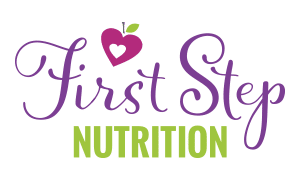
How to Modify Family Meals for your Baby
I am happy to bring you this sponsored post today, thanks to my friends at Baby Gourmet. All thoughts are my own.
Welcoming your baby to the table to eat solid foods is a fun time for everyone! Your little one has probably been interested in watching you eat for a while, and will be excited to finally be included at the family table.
But it also throws a bit of a wrench into the exclusive milk feeding you’ve gotten used to after the past 6 months. Now you have to think of what to feed your baby for solids……
Baby-led weaning or purees?

In Canada, it’s recommended to start with both purees and finger foods from the beginning (around 6 months of age). This is also sometimes described as a“combo,” a “mixed” method, or more of a flexible Baby-led Weaning approach when introducing solids.
One benefit of your baby self-feeding is that he can fully listen to his appetite and learn how to self-regulate. There is no “here comes the airplane” or other pressure from mom or dad (or other caregiver). Even adding in finger foods along with purees will help to improve baby’s finger dexterity, and strength of mouth muscles. Exposing your little one to lots of textures and tastes may prevent some picky eating later on too.
And purees are an easy way to offer your baby important nutrients, like iron! When spoon-feeding your baby, just make sure to practice responsive feeding by watching for baby’s signs of hunger and fullness. Your baby has had enough when she slows down on eating and starts to get distracted. Or your baby may throw food or squirm and cry to get out of the high chair. Time to end the meal!
If offering purees, you can also allow your baby to try and feed themselves, with a “dipping” tool, like my 8 month old baby model below! If buying purees from the store, look for simple ingredients with no added preservatives (except maybe Vitamin C or ascorbic acid). I always get asked about my fave brand, which has always been Baby Gourmet! It’s a local Calgary company, with “real” food ingredients.
How do I modify family meals?
While you will often be able to adapt your own meal and offer it to your baby, keep in mind that she needs more iron and fat than you. The most important nutrient to offer your baby at each meal is a source of iron. This could include meat, poultry, fish, eggs, legumes (beans and lentils) or fortified infant cereals. Offer an iron-rich food twice per day when starting solids.
Some family meals, like chili or slow-cooked meat and steamed veggies are great for baby! Others will be a bit harder for him to eat. Here are some ideas to easily modify family meals to include your baby:
- Soup: Pick out soft chunks if the soup contains noodles, meat and veggies. Or you could puree the soup and serve in a cup to drink. Or if it’s thicker, let baby try and dip with a breadstick or experiment by scooping with a shallow plastic spoon. Love this idea!
- Salad: Your baby won’t be able to eat lettuce or other leafy greens. But you can pick off toppings like chicken, avocado, egg, beans and veggies for your baby to try.
- Spicy or salty food (like a chili or curry): Put baby’s portion in a colander and rinse it under running water to get rid of excess sauce.
- Thicker foods (like greek yogurt, infant cereal or mashed potatoes): Offer a spoon or dipping tool (could be a carrot, breadstick or plastic baby toothbrush) for baby to dip and lick. Next they will be able to stab with a plastic fork, and likely use a spoon for a regular scooping motion closer to a year. Of course, hands work too!!
What if my food isn’t appropriate to offer my baby?
Sometimes your meal is just something that your baby is not yet able to eat. Or maybe not appropriate in terms of nutrition, especially if you eat a lot of take-out and restaurant food.
It’s a great idea to have some easy baby finger-foods around, in case your occasional meal is extra spicy, salty or not what you think your baby should be eating. And sometimes (I know this as a busy mom myself!), these just come in handy on busy nights when you don’t have time to make a baby-friendly meal!
Quick and easy items for healthy dinners for your baby include reheated frozen homemade meatballs, rinsed canned black beans, boiled eggs, sliced avocado or Baby Gourmet meals like Sweet Potato, Apple and Chicken. This is a great mixed dish puree choice, as the vitamin C in the fruit and veggies will help your babe absorb the iron from the chicken. And it actually tastes delicious (not just baby’s opinion!).
Foods to avoid for baby
While you and your baby will be able to share many different foods and meals, there are a few foods that you will want to avoid for your baby. These include:
- Honey until 12 months, due to botulism risk.
- Highly sweetened foods. We don’t want babe growing up with a taste for super sweet foods. And no matter the type of sugar (including maple syrup, agave nectar etc), it’s low in nutrients.
- Salty foods. Your baby’s kidneys are not ready to process a lot of sodium. If you’re preparing food at home, leave the salt out and add it to the adult portions after you’ve served baby.
- Low-fat foods. Items in this category, such as fat-free yogurt or light cheese, aren’t a good choice for little ones. Babies need lots of fat for brain development and growth.
- Raw fish, meat or raw milk: your baby is more prone to foodborne illness, so best not to risk it.
- Artificial sweeteners and colorings. Sweeteners provide no nutritional value, and colorings have been linked to behavior issues in children.
What about all of the packaged snacks marketed to your baby? When looking at the baby food aisle, check out the first few ingredients. If the product mainly white rice, there is not a lot of nutrition.
Baby Gourmet Finger Foods like the Carrot Sticks Lentil & Chickpea Puffs are a good choice, compared to other packaged baby finger foods. They are low in sodium and sugar and based with red lentil and chickpeas for higher protein and iron.
No matter what you’re serving your baby, there are benefits of sitting around the table and eating together as a family. I hope you feel like you have enough information to get started!
Founder of First Step Nutrition | Registered Dietitian Nutritionist
Jen believes raising happy, well-nourished eaters who have a healthy relationship with food doesn't have to be a battle! She is an author and speaker with 18 years of experience specializing in family nutrition and helps parents teach their kids to try new foods without yelling, tricking, or bribing.






No Comments